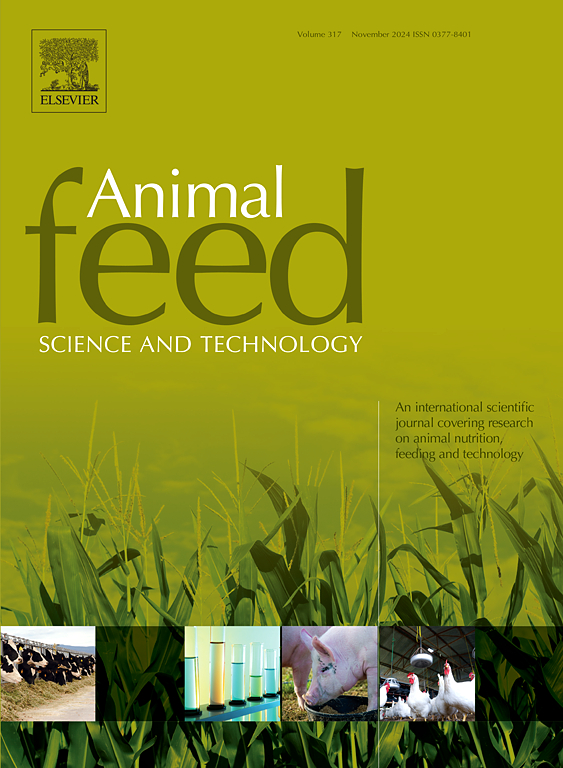The growing area within the United States has only minor impact on digestible and metabolizable energy, and standardized total tract digestibility of phosphorus in full-fat soybeans fed to growing pigs
IF 2.5
2区 农林科学
Q1 AGRICULTURE, DAIRY & ANIMAL SCIENCE
引用次数: 0
Abstract
Two experiments were conducted to test the hypothesis that there is no difference in the digestible energy (DE), the metabolizable energy (ME), or the standardized total tract digestibility (STTD) of P among five sources of full-fat soybeans (FFSB) fed to growing pigs. The five sources of FFSB (source 01, 02, 03, 04, and 05) were collected from five different states in the United States and fed to growing pigs. In experiment 1, forty-eight pigs (initial body weight: 30.86 ± 1.64 kg) were placed in metabolism crates and allotted to six diets using a randomized complete block design with eight replicate pigs per diet. A basal diet based on corn as the only source of energy and five diets containing corn and each source of FFSB were formulated. Pigs were fed experimental diets for 13 days and feces and urine were collected for four days after seven days of adaptation. Results demonstrated that ME in corn was 15.73 MJ per kg dry matter (DM), and ME in the five sources of FFSB was 20.74, 19.85, 20.59, 20.19, and 21.22 MJ ME per kg DM, respectively. In experiment 2, eighty pigs (initial body weight: 16.73 ± 3.16 kg) were housed individually in metabolism crates and allotted to a randomized complete block design with 10 diets and 8 replicate pigs per diet. Five diets contained each source of FFSB as the only source of P and five additional diets were formulated by adding 1000 phytase units (FTU)/kg of microbial phytase to the original five diets. Thus, the experiment was a 5 × 2 factorial with the five sources of FFSB and two levels of microbial phytase (i.e., 0 or 1000 FTU per kg diet). Feces were collected from pigs for four days following five days of adaptation. Results demonstrated that there were no interactions between phytase and source of FFSB, and no effects of phytase or source of FFSB were observed for feed intake, weight of feces excreted, or daily basal endogenous P loss. The STTD of P in the diet with FFSB source 05 was greater (P < 0.05) than the STTD of P in the other sources of FFSB if no phytase was used, but when phytase was added to the diets, no differences among the five sources of FFSB were observed (interaction, P < 0.05). However, the STTD of P was greater (P < 0.05) if phytase was used than if no phytase was used. In conclusion, results demonstrated that there were only minor differences among sources of FFSB in ME and STTD of P in FFSB was not different among the five sources if microbial phytase was used.
美国境内的种植区域对全脂大豆饲用猪的消化能、代谢能和磷的标准化全道消化率只有很小的影响
为验证5种来源的全脂大豆(FFSB)对生长猪磷的消化能(DE)、代谢能(ME)和标准化全道消化率(STTD)均无差异的假设,进行了2项试验。从美国5个州收集5种来源(来源01、02、03、04和05),饲喂生长猪。试验1选用48头初始体重为30.86 ± 1.64 kg的猪,采用完全随机区组设计,饲喂6种饲粮,每种饲粮8头重复。试验配制了以玉米为唯一能量来源的基础饲粮和5种含玉米和不同来源的猪瘟多糖的饲粮。饲喂试验饲粮13 d,适应7 d后收集4 d的粪便和尿液。结果表明,玉米代谢能为15.73 MJ / kg干物质,5个来源的代谢能分别为20.74、19.85、20.59、20.19和21.22 MJ / kg干物质。试验2选用初始体重16.73 ± 3.16 kg的80头猪,分别饲养于代谢笼中,采用完全随机区组设计,每组饲粮10头,每组饲粮8头重复。5种饲粮均以各来源的植酸酵母为磷的唯一来源,在原5种饲粮中添加1000 FTU /kg的微生物植酸酶,分别配制5种饲粮。因此,该试验是5 × 2的因子,涉及5种来源的FFSB和2种水平的微生物植酸酶(即每公斤饲料0或1000 FTU)。在5天适应期后的4天收集猪的粪便。结果表明,植酸酶与饲料来源之间不存在相互作用,且植酸酶和饲料来源对采食量、排粪重和日基础内源磷损失均无影响。在不添加植酸酶的情况下,饲粮中磷的STTD (P <; 0.05)高于其他来源的FFSB (P <; 0.05),但在饲粮中添加植酸酶时,5种来源的FFSB之间无显著差异(相互作用,P <; 0.05)。使用植酸酶组的STTD比不使用植酸酶组的STTD更大(P <; 0.05)。综上所述,如果使用微生物植酸酶,不同来源的FFSB中ME的差异很小,而不同来源的FFSB中P的STTD差异不大。
本文章由计算机程序翻译,如有差异,请以英文原文为准。
求助全文
约1分钟内获得全文
求助全文
来源期刊

Animal Feed Science and Technology
农林科学-奶制品与动物科学
CiteScore
6.00
自引率
6.20%
发文量
266
审稿时长
3 months
期刊介绍:
Animal Feed Science and Technology is a unique journal publishing scientific papers of international interest focusing on animal feeds and their feeding.
Papers describing research on feed for ruminants and non-ruminants, including poultry, horses, companion animals and aquatic animals, are welcome.
The journal covers the following areas:
Nutritive value of feeds (e.g., assessment, improvement)
Methods of conserving and processing feeds that affect their nutritional value
Agronomic and climatic factors influencing the nutritive value of feeds
Utilization of feeds and the improvement of such
Metabolic, production, reproduction and health responses, as well as potential environmental impacts, of diet inputs and feed technologies (e.g., feeds, feed additives, feed components, mycotoxins)
Mathematical models relating directly to animal-feed interactions
Analytical and experimental methods for feed evaluation
Environmental impacts of feed technologies in animal production.
 求助内容:
求助内容: 应助结果提醒方式:
应助结果提醒方式:


